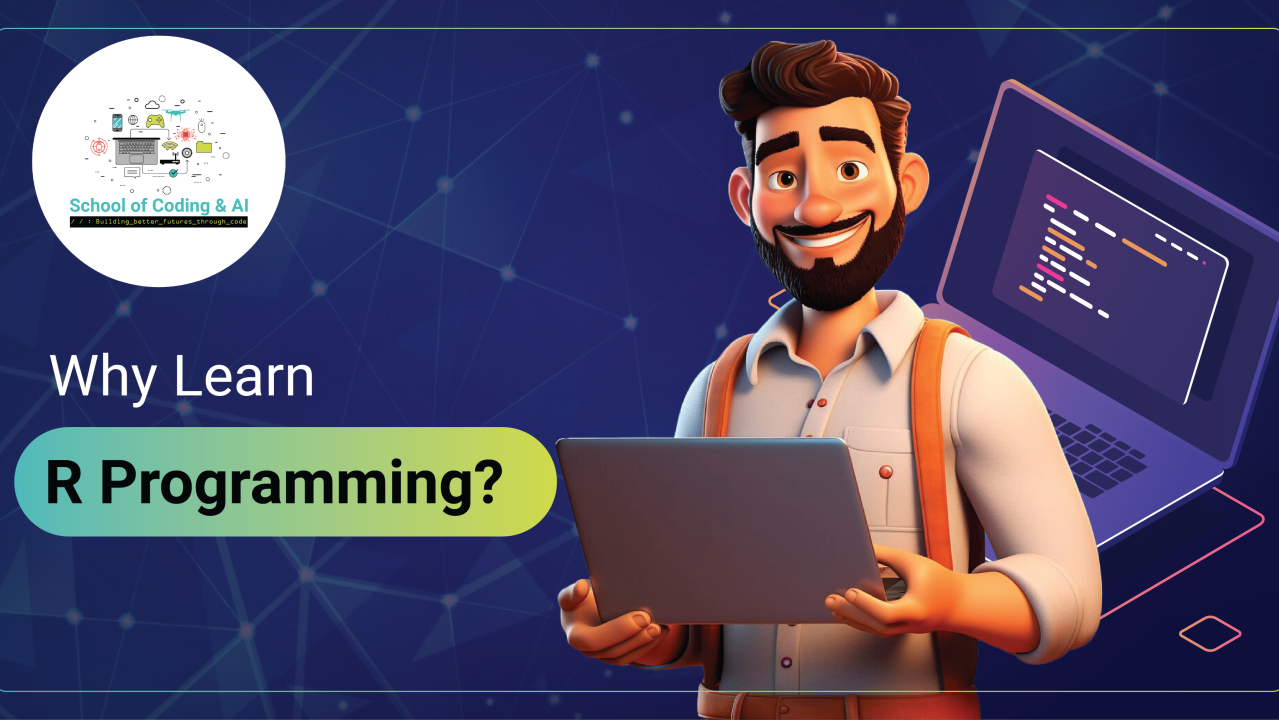
Why Learn R Programming? 5 Compelling Reasons to Start Today
School of Coding & AI
Transforming Futures with the UK’s Leading Coding & AI Training Provider | Equipping Individuals & Businesses for Succes
Introduction
In today’s data-driven world, the ability to analyze and make sense of data is a crucial skill. Whether you are a data scientist, analyst, or even a researcher, learning a powerful statistical programming language like R can open a world of opportunities. If you’ve ever asked yourself, “Why should I learn R programming?” this article is for you. In this blog, we’ll explore why R has become one of the go-to languages for data analysis and statistical computing. By the end, you'll know exactly how R can help elevate your career and projects.
What is R Programming?
R is an open-source programming language that is particularly popular among statisticians, data scientists, and researchers. It’s specifically designed for data analysis, data visualization, and statistical computing. R provides an extensive ecosystem of libraries and tools, making it a versatile choice for anyone working with data.
Why Learn R Programming? 5 Key Reasons
1. R is Tailored for Data Science and Analytics
One of the most compelling reasons to learn R is its dominance in data science and analytics. According to recent studies, data scientists spend around 80% of their time cleaning and preparing data. R’s specialized packages, such as dplyr for data manipulation and ggplot2 for visualization, allow users to streamline these tasks efficiently.?
In fact, a 2023 survey by O’Reilly Media found that 40% of data professionals rely on R for data analytics. This high adoption rate means you’ll be in good company and have access to a robust, active community.
2. Open Source and Cost-Effective
Unlike many programming languages that require expensive licenses, R is entirely free and open-source. This makes it accessible to anyone looking to learn without worrying about budget constraints. Additionally, the language is constantly updated and improved by a vibrant community of developers who contribute to its extensive repository of packages.
For example, CRAN (Comprehensive R Archive Network) has over 18,000 contributed packages, allowing you to tailor R for virtually any kind of data task you encounter.
3. Excellent for Data Visualization
If you’re looking to present your data in compelling ways, R is known for its data visualization capabilities. With R, you can create stunning, publication-quality graphs, charts, and maps. The ggplot2 library alone is widely regarded as one of the best data visualization tools available.
R offers endless possibilities for creating highly customizable and interactive visuals. This is invaluable in both business environments, where data storytelling is key, and in academia, where publication-ready charts are required.
4. Widely Used in Academia and Research
R programming is the leading choice in the academic and research world. Many universities worldwide include R as part of their curriculum in statistics, econometrics, and data analysis courses. R is often the default choice for statisticians in social science research, biology, and even economics.
If your career path involves research or higher education, having R in your skillset will give you a significant advantage. Plus, it's frequently cited in scientific publications, giving your research the statistical rigor that peers and journals expect.
领英推荐
5. High Demand in the Job Market
The demand for data science professionals has skyrocketed in recent years. In 2023, job listings for data analysts, data scientists, and statisticians almost doubled compared to previous years, with a 45% increase in R programming skills being mentioned in job postings.
By learning R, you open yourself up to opportunities across various sectors, including finance, healthcare, marketing, and academia. Many employers today seek professionals with expertise in both data science and R programming due to the value these skills bring to business analytics and decision-making processes.
Frequently Asked Questions
Q1: Is R programming hard to learn?
R programming is beginner-friendly, especially if you have some prior programming experience. Even if you’re new to coding, R’s intuitive syntax and the vast number of tutorials available make it accessible.
Q2: Who should learn R programming?
R is ideal for data analysts, data scientists, researchers, statisticians, and anyone involved in data-driven projects. It's also great for students looking to break into these fields.
Q3: Can I use R for machine learning?
Absolutely! R offers many machine learning libraries, such as caret, randomForest, and e1071, which allow you to create predictive models easily.
Q4: How does R compare to Python?
While Python is more versatile for general-purpose programming, R is unmatched for data analysis and visualization. Many data scientists choose to use both languages, depending on the task at hand.
Q5: Is R relevant in 2024?
Yes, R remains highly relevant, especially in data-centric industries like academia, finance, and healthcare. It continues to evolve, with new packages and updates released frequently.
Conclusion
R programming is not just a valuable tool but a gateway to a plethora of opportunities in the data science realm. Whether you're aiming for a career in data analytics, statistical research, or machine learning, R offers the right combination of power, flexibility, and cost-effectiveness. Its strong community, open-source nature, and extensive libraries make it a top choice for professionals worldwide.
Now that you’ve seen why learning R is so beneficial, why wait? Dive into R programming today and unlock a world of data-driven opportunities.